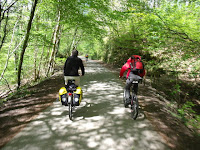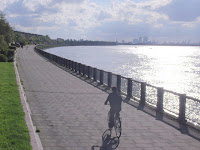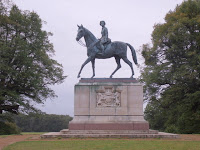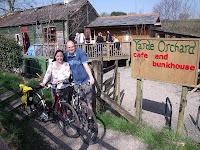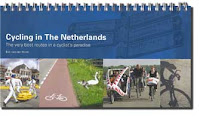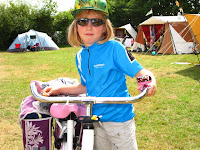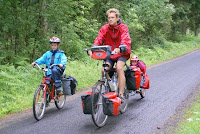
Generally, you’ll find segregated cycle paths alongside busier roads. These are generally of a high quality, designed to keep even racing cyclists going at a reasonable speed. This means a smooth surface, no tight corners, priority at side road crossings and no sudden endings like we see so often in the UK. Where there are no cycle paths (and yes, there are many Dutch roads without cycle paths!) severe traffic-calming has been put in place to ensure cyclists have just an enjoyable experience as like they were cycling traffic-free.

To demonstrate this Dutch dual approach, I asked my retired dad to take some pictures of his weekly 6 km (3.7 miles) ride between two suburban towns just south of Amsterdam. His ride starts in a housing estate in my old hometown Uithoorn and ends at the leisure centre in Aalsmeer, where my dad normally plunges in the pool for a well-deserved swim.
On the map you'll find on-road route sections marked in blue and traffic-free "segregated" route sections in green. Note there are various routes available, like a southern scenic route via a quiet country lane. This route is nearly entirely on-road and is marked with a dotted line. In this article we limit ourselves to the most direct route; the route a commuting cyclist would take. Note though that many Dutch cyclists would opt for the longer on-road route if they were cycling for leisure, as it takes them away from traffic noises. This example also shows how distinguished Dutch cyclists are; they use different routes for different types of cycling. UK cyclists are not different in that way, but they have generally hardly a choice!
Looking at the first picture of the "commute route", you’ll see the homes and the paved roads which still look much the same as when I grew up in the 1980s. Since then, there have been some significant on-road changes though to keep cycling fun and enjoyable. A 30 km/h (20mph) speed limit is now in force for the whole area, enforced by high speed bumps at every junction.
Cycling is easy in another residential street where a 20 mph speed limit is in force. Again, speed bumps have been put in place, despite the fact that this road generally only gets used by those who live here. At the end of this road, my dad takes a short-cut away from the residential area, which has been here since the estate was built; a wide well-lit cycle path with segregated space for pedestrians.
Those with eye for detail will spot the sign showing the end of the 30km/h (20 mph) speed limit along this path, put in place for mopeds. Dutch road designers still haven’t found the dream solution for moped road users. Although the speed limit for mopeds is now officially reduced to 20 mph on this type of path (see article comment), signs like this are still around; this detail shows that not all is good and green in The Netherlands…
The next section of our route will especially alarm fans of Sustrans cycle paths on dismantled railway lines. Via a traffic-free zig-zag, my dad now cycles into a cycle path tunnel parallel to a bus route, both on the course of a dismantled railway line. In a space of about 16 m wide, the Dutch have managed to squeeze in a dual lane bus route with various stops and a wide cycle path.
This might be a far cry from the traditional English “greenway” railway paths, but this Dutch railway cycle path scores high in terms of social safety. It is extremely well lit and the high frequency of buses makes that women happily use this cycle route in the dark. This factor of social safety gets often overlooked in the UK when designing cycle paths! Slightly over the top are the traffic lights and barriers at every crossing of the bus route; money spent on this could well get used for cycling infrastructure in the UK!
Further west, the cycle path naturally joins a cycle path alongside a busy main road. This picture shows where this cycle path crosses a side road. This side road used to be a quiet country lane when I was young and a cycle path crossing with priority for cyclists used to be sufficient. Since then, this area has been increasingly taken over by the Dutch greenhouse industry, so, to secure a safe crossing for cyclists amidst increasing traffic, these lights have been installed. Note one press on a button is enough to cross the entire side road!
Another cycle path away from this main junction takes us now south, where another cycle path “short-cut” takes us into another housing estate. This is where my dad’s cycle journey becomes on-road again and it is therefore greatly important that you notice the 30 km/h (20mph) speed limit signs.
Again, this shows how well the Dutch road system caters for cyclists. The segregated cycle path route ends, but there is immediately a 20mph speed limit kicking in to protect cyclists on their further on-road journey. No further speed limit enforcement is in place in this housing estate, but another continental “traffic calmer” here is the “traffic from the right goes first”-rule. There are many side roads on this road and in contradiction of what a UK-road user might think, “minor road”-users from the right go first here, making it essential to reduce speeds to be able to stop for this side traffic.
The journey ends on a slightly busier road in this Aalsmeer housing estate. Wide cycle lanes are in place here and those with eye for detail will notice how these cycle lanes are continuous at the zebra crossing and the island in the center of the road. In the UK, cycle lanes always stop at this point, leading to potential hazardous situations with cars pushing into the narrow lane between the island and a potentially squeezed cyclist. This picture, with the red car turning right, also explains something else. In The Netherlands, this type of cycle lanes is wide spread and Dutch drivers learn in their driving lessons always to look in their mirrors and then to look over their shoulders to check for cyclists when turning across this type of cycle lane; the cyclist straight on should go first! This driver's attitude is light years away from the attitude of a typical UK driver. He/she probably wouldn't even notice the cycle lane and definitely wouldn't look so extensively for cyclists before turning. This is an important reason why cycle lanes alongside two lanes of traffic like pictured here often don't work in the current UK conditions.
This last remark is an important issue when trying to implement Dutch cycling infrastructure solutions to the UK. The current Dutch cycling infrastructure and road calming are a result of a 40 year evolution and Dutch people are completely accustomed to it. British people have been brainwashed by 5 decades of motorised priority and generally just don't care about cyclists. This means that many Dutch concepts will need to be adjusted to the UK situation and carefully introduced. Authorities must become much more aware of the need for a change of driver's behaviours with a serious, serious reduction of speed on many, many roads. Another issue is that most Dutch housing estates are built post WWII and very spacious, whilst many English urban areas are dating from the Victorian age and very densely built, not to mention its more hilly nature. This makes the task ahead challenging, but not impossible.
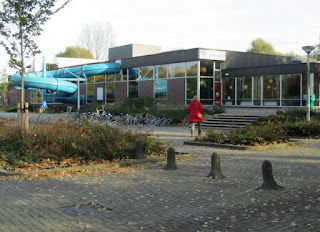 Whatever the way, it will always be a combination of “sharing the road” and “segregated” models. It can never be one or the other, just like in The Netherlands. Some positive notes from a UK-perspective; Bikeability is a great tool to make more people comfortable with on-road cycling and UK-style “Sheffield” bike stands replace more and more classic Dutch bike stands as in this picture at the Aalsmeer leisure centre; my dad will have to get used to them. For now; thanks for the pictures dad; have a good swim and enjoy the ride back!
Whatever the way, it will always be a combination of “sharing the road” and “segregated” models. It can never be one or the other, just like in The Netherlands. Some positive notes from a UK-perspective; Bikeability is a great tool to make more people comfortable with on-road cycling and UK-style “Sheffield” bike stands replace more and more classic Dutch bike stands as in this picture at the Aalsmeer leisure centre; my dad will have to get used to them. For now; thanks for the pictures dad; have a good swim and enjoy the ride back!
What about getting on your bicycle yourself with one of my "Cycling Dutchman" guidebooks?
 Cycling in Amsterdam and The Netherlands - The very best routes in the cyclist's paradise makes you travel beyond Dutch cliches like clogs, windmills and the Amsterdam red light district, allowing you to truly explore the lowlands. The book features 1064 kms of routes and has special chapters explaining the unique Dutch cycling-minded traffic rules and its cycle route signage systems; 164 pages, colour, wiro bound, fits in standard handlebar bag, see also http://www.cyclinginholland.com.
Cycling in Amsterdam and The Netherlands - The very best routes in the cyclist's paradise makes you travel beyond Dutch cliches like clogs, windmills and the Amsterdam red light district, allowing you to truly explore the lowlands. The book features 1064 kms of routes and has special chapters explaining the unique Dutch cycling-minded traffic rules and its cycle route signage systems; 164 pages, colour, wiro bound, fits in standard handlebar bag, see also http://www.cyclinginholland.com.



 Dutch style bike rides in the United Kingdom:
Dutch style bike rides in the United Kingdom:


The London - Land's End Cycle Route Book is designed for those who LOVE cycling, but don't like traffic. The book takes you onto the most beautiful cycle routes of southern England, including the Camel Trail, Devon Coast to Coast Route, Bristol and Bath Railway path, Thames Valley route and many more! What makes the book unique is that the route is completely continuous, including detailed directions and local knowledge all the way. Get inspired; choose your favourite route sections or go for a full summer holiday adventure; 164 pages, colour, wiro bound, fits in standard handlebar bag, see http://www.london-landsendcycleroutebook.com.
Other popular Cycling Dutchman blog articles:
Other popular Cycling Dutchman blog articles:
Explaining Dutch cycling infrastructure:

.jpg)



